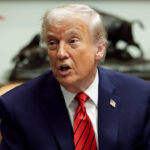The United States and Ukraine praised the first round of talks in Geneva on Sunday, calling the long-awaited talks “productive.”
Both sides said they had drafted an “updated and sophisticated peace framework” to move forward.
What does this framework include? How much has changed between the original plan reportedly drafted by Washington and Russia and the plan revised first by the European Union and then by the U.S. and Ukrainian delegations in Geneva?
What has changed?
Over the weekend, the EU reportedly issued a counter-proposal to the original US-Russia framework, the leaked content of which was seen as favorable to Russia.
The leaked EU plan includes major adjustments, including capping Ukraine’s military at 800,000 troops in peacetime rather than the originally proposed 600,000.
There are also significant changes regarding Kiev’s NATO aspirations. Ukraine’s membership in NATO requires the agreement of alliance member states, rather than a promise that NATO will not accept Ukraine. Notably, some point out that NATO forces are not stationed on Ukrainian territory under their command, but only in peacetime.
One of the most important aspects for Kiev is the Russian-occupied territory of Ukraine.
A leaked EU-led proposal would withdraw recognition of temporarily occupied territories in Ukraine, which was included in the original US-Russian framework.
The land in question includes Ukraine’s Luhansk and Donetsk oblasts, which make up Donbass.
The counterproposal also calls for Washington-led security that mirrors NATO Article 5.
NATO Article 5 is a hallmark of the alliance, and when invoked, an attack on one member state is considered an attack on all members.
Most importantly, the leaked EU-led counter-proposal reinstates the “ceasefire first” principle that Ukraine has insisted on from the beginning.
“All negotiations regarding territorial exchange begin at the line of contact.”
The Russian government has opposed this approach whenever it has been proposed by Ukraine and its Western allies, including the United States.
After meeting with Russian President Vladimir Putin in Alaska in August, US President Donald Trump expressed support for establishing a ceasefire at the current line of contact before talks between Kiev and Moscow take place.
Will Russia agree to a revised plan?
The Brussels-led counter-offer maintains several concessions from Ukraine, including allowing Russia to return to the G7, which included Russia before it unilaterally annexed Crimea in 2014.
It also includes easing sanctions on Russia, which will be “discussed and agreed in stages” on a “case-by-case” basis.
A leaked European counter-proposal reportedly calls for the Zaporizhzhia nuclear power plant to be placed under international control and for electricity generation to be shared between Ukraine and Russia.
However, this is a territorial concession that Russia has insisted on.
If an agreement is reached between the U.S. and Ukraine, the U.S. government would need to communicate a tailored proposal to the Kremlin.
Two aspects of the new draft framework stand out and are likely to hinder the process: the principle of a ceasefire before negotiations and the recognition of temporarily occupied territories in Ukraine.
Moscow resumed its offensive into eastern Ukraine’s Donbas region, with the heaviest fighting occurring in the Pokrovsk region.
According to the US-based Institute for War Studies think tank, even with the current pace of progress and huge resource commitment, Russian forces will only be able to control the rest of the Donetsk region by August 2027.
Apart from eastern Ukraine, the Russian military has stepped up offensive operations in the southern Zaporizhzhya region.
In addition, Russia has significantly stepped up its airstrikes against Ukraine, particularly targeting the country’s civilian energy infrastructure ahead of the cold winter.
What is the reaction in Moscow?
Kremlin spokesman Dmitry Peskov said Russia had not yet received an official letter of the new proposal after the Geneva talks. Remarkably, the Kremlin calls this an “American” plan, without mentioning Ukraine or the EU’s opinion.
The most important points for Moscow are listed in the first leaked framework, including the rejection of Ukraine’s membership in NATO and the alliance’s commitment not to integrate Kiev, according to Kremlin-controlled media reports.
Also, key demands from the Kremlin remain that the United States and other countries recognize Russia’s sovereignty over Russian-annexed Crimea and Donbas, and the withdrawal of Ukrainian troops from occupied territories in the Donetsk region.
But even these maximalist demands have been criticized by Russian officials and are widely seen as not going far enough.
Russian Deputy Foreign Minister Sergei Ryabkov said Saturday that Russia cannot deviate from demands made by President Vladimir Putin at the Alaska summit in August, reiterating Russia’s commitment to achieving its “goals” in Russia’s war against Ukraine.
Alexei Zhuravlev, deputy chairman of Russia’s State Duma Defense Committee, said the US peace plan was aimed at maintaining “the threat on Russia’s borders” and was likely referring to Ukraine’s existence as a sovereign state and the borders Russia shares with NATO members such as Poland and the Baltic states.








